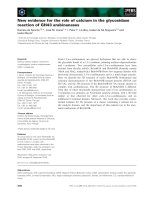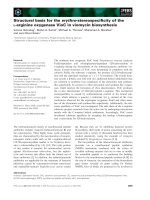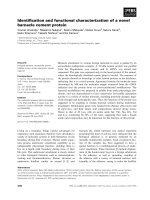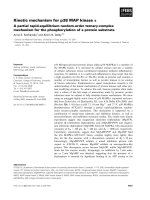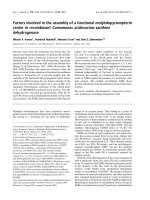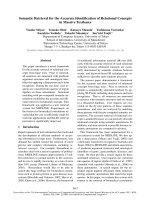Báo cáo khoa học: "SOFTWARE TOOLS FOR THE ENVIRONMENT OF A COMPUTER AIDED TRANSLATION SYSTEM" pptx
Bạn đang xem bản rút gọn của tài liệu. Xem và tải ngay bản đầy đủ của tài liệu tại đây (241.66 KB, 4 trang )
SOFTWARE TOOLS FOR THE ENVIRONMENT OF A COMPUTER AIDED TRANSLATION SYSTEM I
Daniel BACHUT - Nelson VERASTEGUI
IFCI GETA
INPG, 46, av. F~lix-Viallet Universit~ de Grenoble
3803] Grenoble C~dex 38402 Saint-Martin-d'H~res
FRANCE FRANCE
ABSTRACT
In this paper we will present three systems,
ATLAS, THAM and VISULEX, which have been designed
and implemented at GETA (Study Group for Machine
Translation) in collaboration with IFCI (Institut
de Formation et de Conseil en Informatique) as
tools operating around the ARIANE-78 system. We
will describe in turn the basic characteristics of
each system, their possibilities, actual use, and
performance.
I - INTRODUCTION
ARIANE-T8 is a computer system designed to
offer an adequate environment for constructing
machine translation programs, for running them,
and for (humanly) revising the rough translations
produced by the computer. It has been used for a
number of applications (Russian and Japanese,
English to French and Malay, Portuguese to English)
and has been constantly been amended to meet the
needs of the users[Ch. BOITET et al., 1982].In this
paper, we will present three software tools for
this environment which have been requested by the
systemts users.
II - ATLAS
ATLAS is an Kid
to the
linguist for introdu-
cing new words and their associated codes into a
coded dictionary of a Computer Aided Translation
(CAT) application.
Previously, linguists used indexing manuals
when adding new words to dictionaries. These
manuals contained indexing charts, sorts of graphs
enabling the search for the linguistic code asso-
ciated with a given lexical unit in a particular
linguistic application. The choice of one path in
a chart is the result of successive choices made at
each node. This may be represented by associating
questions to each node and the possible answers to
the arcs coming from a node ; the leaves of the tree
bear the name of the code and an example.
A language to write the "indexing charts" is
provided to the linguist. An ATLAS session begins
with an optional compilation phase. Then, the
system functions in a conversational way in order
to execute commands.
The main functions of ATLAS are the following :
- Editing and updating of indexing charts : compi-
lation of an external form of the chart, and
modification of the internal form through inte-
raction with the user, with the possibility of
returning a new external form.
-
Interpretation of these charts, in order to
obtain the linguistic codes and the indexing of
dictionaries. A chart is interpreted like a
menu, so that the user can traverse the charts
answering the questions. He can also view the
code found, or any other code, by request, and
examine and update the dictionary by writing the
code in the correct field of the current record.
- Visualisation of charts in a tree-like form in
order to build the indexing manuals.
In the case of interpretation, the screen is
handling as a whole by the system : it manages
several fields such as the dictionary field, the
chart field and the command field.
The system is written in PASCAL, with a small
routine in assembler for screen-handling.
Below, we give two examples :
- The first is a piece of tree built by the system
based on an indexing chart.
-
The second is a screen such as the user sees it
in the interpretation phase.
1noun both :
lregular
and •
:variable?
!
! :
yes
i : ÷ -t INVN : Iuuage
e
! :~ :NIRG: is
the
I +- -~noun
invariable
! :?
! :
yes
' : + -21NVHZ :
leaf
!
! : sinsular :NIRR|: is
the
t :
÷
Rslngular
! : :~biguous?
! : : :
! : : :
no
! : ÷ 21NVN:
mouse
:no
:NIRR:
there are
t
!
+
-I
2
bases Co
be
! : indexed
!
! t
yes
: + -~INVNZ :
leaves!
i : . !
:plural :NIRR2:
is
the !
i + ~plural !
:ambiguous? !
: no !
! +
"~ I ~,'N :
mice !
I
Work supported by ADI contract number 83/175 and
by DRET contract number 81/164.
330
+
!
INTERPRETEUR
DE MENUS
!NREG(q) : 'what is the
noun type
?';
! type |
plural with
S
! type
2
== plural with ES
! type 3 sing with Y, plural with
lea
! 1 : 'type 1, ambigoous' > NIZ(v) :
'type';
! 2 : 'type 1, non ambiguous' > Nl(v) :
'folder';
! 3 : 'type 2. mb~guous' > N2Z(v) : 'flalh';
! 4 : 'type 2. non ambiguous' > N2(v) : 'c:ockroach';
! 5 : 'type 3, mablguous' > N3Z(v) : 'fl(y)';
! 6 : 'type 3, non ambiguous' > N3(v) :
'propert(y)'.
! > &env NI
!WENT
==INVI
( ~'PRET ,GO ) •
!WERE INVI (~RE ,BE ) •
!WHAT
INVI
(WHICH
,WHAT
).
! .= ( , ).
+
Figure 2. Screen Display during Interpretation
Phase.
III - THAM
Computers can help translators in several
ways, particularly with Machine Aided Human Trans-
lation (MAHT). The translator is provided with a
text editing system, as well as an uncoded
dictionary which may be directly accessed on the
screen. But the translation is always done by the
translator.
THAM consists of a set of functions programmed
in the macro language associated with a powerful
text editor. These functions help the translator
and improve his effeciency.
The conventional translation of a text is
generally performed in several stages, often by
different people : a rough translation followed by
one or several revisions : linguistic revision,
"postediting", or "technical revision". Hence, the
THAM system works with four types of objects :
source text (S), translated text (T), revised text
(R) and uncoded dictionary (D). In the actual
system, each of these objects corresponds to one
"file".
The file S contains the original text to be
translated, the file T contains the rough transla-
tion resulting from a mechanical translation or a
first unrevised human translation.
The uncoded dictionary is composed of a sorted
list of records following a fairly simple syntax.
The access key is a character string followed by
the record content, on one or several lines, in a
free format. In general, the "content" gives one
or several equivalents, but it can also contain
definitions, examples, and equivalents in several
languages : it is totally free (and uncontrolled).
Finally, the file R is the final translation
of the original text realized by the user from the
three previous files.
THAM is designed for display terminals. It
can simultaneously display one, two, three or four
files, in the order desired by the user. The screen
is divided into variable horizontal windows. The
user can consult the dictionary with an arbitrary
character string (which may be extracted from one
of the working files), update the dictionary,
insert into the revision file a part of another
file, make permutations or transpositions of
several parts of a file, and receive suggestions
for the translation of a word displayed in a win-
dow. Moreover, the system can simultaneously use
many source, translation, dictionary or revision
files.
Basic ideas for THAM come from various
sources such as IBM's DTAF system (only used
in-house on a limited scale) and [A. MELBY's TWS
|982].Initial experiments have shown this tool to
be quite useful.
IV - VISULEX
VISULEX is a handy and easy-to-use visualisa-
tion tool designed to reassemble and clearly
distinguish certain information contained in a
linguistic application data base. VISULEX is
intended to facilitate the comprehension and
development of coded dictionaries which may be
hindered by two factors : the dispersal of infor-
mation and the obscurity of the coding. In
ARIANE-78, the lexical data base may reside on
much more 50 files, for a given pair of language.
This data base is composed of dictionaries,
"formats" and "procedures" of the analysis, trans-
fer and synthesis phases (the 3 conventional
phases of a CAT system). For any given source
lexical unit in this data base, VISULEX searches
for all the associated information.
VISULEX offers two levels of detail. At the
first level, the information is presented by using
only the comments associated with the codes found.
At the second level, a parallel listing is
produced, with the codes themselves, and their
symbolic definition. The first level output can be
considered as the kernel of an "uncoded dictionar~
The system provides, on one or several output
units, a formated output, with these different
visualisation levels.
This system can be considered to have several
possible uses :
- as a documentation tool for linguistic
applications ;
-
as a debugging tool for linguistic applications ;
-
as a tool for converting the lexical base into
a new form (for instance, loading it into a
conventional data base).
It is possible to imagine VISULEX results
being used as a pedagogical introduction to a CAT
application, seeing that the output form is more
comprehensible than the original form.
For the Russian-French application, VISULEX
output gives two listings of around 150,O00 lines
each. This makes it a lot easier to detect
indexing errors, at all levels. This is a first
step towards improved "lexical knowledge
processing".
Finally, we give an example of a VISULEX
output. The chosen lexical unit is "CHANGE" in the
English-French pedagogical prototype application.
The two levels are showed (the left column corres-
pond to the first level, the right column to the
second) .
331
+ ++
+
!VISULEX Version-I BEXFEX 11:31:54 [I/29/83 Niveau:
1 Page
I!?VISULEX Version-I BEXFEX II:31:54 11/29/83 Niveau:
!'CI~NGE' !!'CHANGE'
! !,
! morphologie !! morphologie
! CHANGE !?
PNIFITFO:
! process verb !! PROCV:SEM-E-PROC,SEMV-E-PROC
! Is! valency: N, infinitive clause and from; 2nd valency: to and for !! NIFITOFO:VLI-E-N-U-I-U-FROM, VL2-E-TO-U-FOR
[! JPCL-E-BACK-U-OVER
! ambiguous verb, possible endings : E, ES, ED, ING (ex state) !! V2Z:CAT-E-V,SUBV-E-VB,VEND-E-2
! CHANG-
!!
CHANG-
! first valency : IN and for and from !! INFRFOI:VLI-E-IN-U-FROM-U-FOR
? ambiguous (or key word of an idiom) noun derived from a verb, !! DVNIZ:CAT-E-N,SUBN-E-CN,DRV-E-VN,NUM-E-SIN,NEND-E-I
! and which take an 's' for the plural (ex change) 1!
! CHANGE- !! CHANGE-
! equivalents l! equivalents
! l!
! si: la valence l = nomet la valence 2 - for !! si: ZN2FO:VLI-E-N -ET- VL2-E-FOR
! 'CHANGER' !! 'CHANGER'
! NOEUD TERMINAL: RL, RE, ASP ET TENSE SONT NETTOY~S !! INT:RL:-RLO, RS:=RSO, ASP:+ASPO, TENSE:=TENEEO
t la valence l = nom, la valence 2 - pour + nom !! ZN2PON:VALI:-N,VAL2:-POUKN
! c'est un verbe pouvant d~river en nom d'action (VN) ou en !! KVDNPAN:CAT:=V,POTDRV:=VN-U-VPA-U-VPAN
? adjectif passi f (VPA) ou en nom (AN)
! 'CHANG'
! FOND+ER,EMENT,EUR,ANT
! si: la
valence 1
= in
! 'CHANGER'
! NOEUD TERMINAL: EL, RE, ASP ET TENSE SONT NETTOY~S
] c'est un verbe pouvant d~river en nom d'action (VN)
! la valence l =
de
+ nom
! 'CHANG'
! FOND÷ER,EMENT,EUR,ANT
t si: la valence
1 =
nomet la valence
2
=
into
! 'TRANSFORMER'
! NOEUD TERMINAL: RL, RS, ASP ET TENSE SONT NETTOY~S
! la valence
l
=
nom, la valence
2
- an + nom
t?
!! 'CHANG'
!! VIAMENTI:FLXV-E-AIMER,DRNV-E-EMENTI
!! si: ZIN:VLI-E-IN
!! 'CHANGER'
!! INT:RL:=RLO, RS:=RSO, ASP:=ASPO, TENSE:-TENSEO
!! KVDN:CAT:=V,POTDRV:-VN
!! ZDEN:VALI:=DEN
!! 'CHANG'
!! VIAMENTI:FLXV-E-AIMER,DRNV-E-EMENT]
!! si: ZN21T:VLI-E-N -ET- VL2-E-INTO
!! 'TRANSFORMER'
!! INT:RL:=RLO, RS:'RSO, ASP:=ASPO, TENSE:=TENSEO
!! ZN2ENN:VAL|:-N,VAL2:'ENN
!
c'est
ua
verbe
pouvant d~river
en
nom
d'action (VN)
on en
! adjectif
passif
(VPA) ou en nom (AN)
! 'TRANSFORM'
! PERFOR+ER,ATION,ATEUR=AGENT
ET
ADJECT
!+-s[: la valence ! = from et la valence 2 = to
! 'PASSER'
! NOEUD TERMINAL: RL, RS, ASP ET TENSE SONT NETTOY~S
! la valence I - de + nom, la
valence
2 + ~ + nom
! c'est un verbe pouvant d~river en nom d'action (VN) ou en
! adjectlf passif (VPA) ou en ham (AN)
! 'PASS'
! ECLAIR+ER,EUR,ANT,AGE
! si:
particule = over
! 'PASSER'
! NOEUD TERMINAL: RL, RS, ASP ET TENSE SONT NETTOY~S
!
e'est
un verbe pouvant d~river
en
nom d'action (VN)
! la valence ] - de + nom, la valence 2 - ~ + nom
! 'PASS'
t ECLAIR+ER,EUR,ANT,AGE
! sinon:
! 'CHANGER'
? NOEUD TERMINAL: EL, RE, ASP ET TENSE SONT NETTOY~S
! c'est un verbe pouvant d~river en nom d'action (VN) ou en
? adjectif passif (VPA) ou
en
nom (AN)
! la valence
1 =
nom
! 'CHANG'
! FOND+ER,EMENT,EUR,ANT
!! KVDNPAN:CAT:'V,POTDRV:-VN-U-VPA-U-VPAN
!! 'TRANSFORM'
!! VIBION2:FLXV-E-AIMER,DRNV-E-ATION2
!! si: ZFR2TO:VLI-E-FROM -ET- VL2-E-TO
!? 'PASSER'
!! INT:RL:-RLO, RS:=RSG, ASP:=ASPO, TENSE:-TENSEO
!! ZDEN2AN:VALI:=DEN,VAL2:=AN
!! KVDNPAN:CAT:-V,POTDRV:=VN-U-VPA-U-VPAN
!! 'PASS'
!! VIAAGI:FLXV-E-AIMER,DRNV-E-AGEI
!! si: JPOV:JPCL-E-OVER
!! 'PASSER'
!! INT:RL:=RLO, RS:=RSO, ASP:=ASPO, TENSE:'TENSEO
!! KVDN:CAT:-V,POTDRV:=VN
!? ZDEN2AN:VALI:=DEN,VAL2:-AN
!! 'PASS'
!t VIAAGI:FLXV-E-AIMER,DRNV-E-AGEI
t! sinon:
[!
'CHANCER'
!! INT:RL:-RLO, RS:=RSO, ASP:=ASPO, TENSE:-TENSEO
!! KVDNPAN:CAT:=V,POTDRV:-VN-U-VPA-U-VPAN
t~
!!
ZNN:VALI:-N
!! 'CHANG'
!! VIAMENTI:FLXV-E-AIMER,DRNV-E-EMENT]
2 !
!
!
!
!
!
!
!
!
!
!
!
!
!
!
t
!
!
!
!
!
!
!
!
!
!
l
!
I
I
!
I
!
!
t
!
!
!
t
!
!
!
!
!
!
!
t
!
!
t
!
!
!
!
÷ ~ ++ ÷
Figure 3. The two levels of VISULEX output
V - CONCLUSION
These software tools have been designed to be
easily adaptable to different dialogue languages
(multilinguism). The development method used is
conventional structured, modular and descending
programming. Altogether the design, programming,
documentation and complete testing represent
around two man/years of work. The size of the
total source code is around |5,000 PASCAL lines
and 4,500 EXEC2/XEDIT lines, comments included.
The ARIANE-78 system extended by ATLAS, THAM
and VlSULEX is more comfortable and more homoge-
neous for the user to work with. This is the first
version, and we already have many ideas provided
by the users and our own experience for improving
these systems.
332
VI - REFERENCES
BACHUT D.
"ATLAS
-
Manuel d'Utilisation", Document
GETA/ADI, 37 pp., Grenoble, March ]983.
BACHUT D. and VERASTEGUI N.
"VISULEX -
Manuel d'exploitation sous CMS",
Document GETA/ADI, 29 pp., Grenoble,
January 1984.
BOITET Ch., GUILLAUME P. and QUEZEL-AMBRUNAZ M.
"Implementation and conversational environment
of ARIANE-78.4, an integrated system for
translation and human revision", Proceedings
COLING-82, pp. 19-27, Prague, July 1982.
MELBY A.K.
"Multi-level translation aids in a distributed
system", Proceedings COLING-82, p. 2]5-220,
Prague, July 1982.
VERASTEGUI N.
"THAM - Manuel d'Utilisation", Document
GETA/ADI, 35 pp., Grenoble, May ]983.
333



